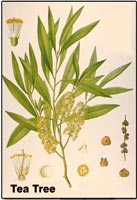Why do I need to know about essential oils?
There is a growing body of research from laboratory and clinical studies that points to the remarkable healing properties of essential oils. They are widely available in markets, co-ops, and pharmacies and are increasingly used in clinics and hospitals.
While most essential oils are safe and free of adverse side effects when used properly, it is important for you to pay attention to dosage, purity, administration, and possible interactions with other medications you might be taking. You should also look for quality products, as there can be big differences between what a professional aromatherapist would use and what is sold in retail stores.
What are common therapeutic uses?
Here are some common therapeutic uses for a few essential oils:
| Tea Tree (Melaleuca alternifolia) | Bacterial, fungal, and viral infections |
| Peppermint (Mentha piperita) | Headaches, fever, nausea, and fatigue |
| Lavender (Lavandula angustifolia) | Minor burns, insomnia, pain relief, and wound care |
| German chamomile (Matricaria recutita) | Inflamatory skin problems |
| Bergamot (Citrus bergamia) | Mild antidepressant and tonic |
| Rosemary (Rosmarinus officinali) | Stimulant and anti-infective agent |
| Eucalyptus (Eucalyptus globulus, Eucalyptus radiata, Eucalyptus smithii) | Respiratory infections |
| Ginger (Zingiber officinalis) | Nausea and inflammation |
| Lemongrass (Cymbopogon citratus) | Fungal infections |
| Basil (Ocimum basilicum) | Insect repellent and anti-parasitic |
| Mandarin (Citrus reticulata) | Stomach upset and restlessness, particularly in children |
What is the difference between "aromatherapy" and "essential oil therapy"?
Basically, these terms mean the same thing. Also, the name "aromatherapy" implies that smelling, or inhaling, essential oils is the only way to get therapeutic benefit, but there are actually a number of ways to use essential oils.
While we think the term "essential oil therapy" is a more descriptive name for this topic, we refer to it as "aromatherapy" because it currently has better name recognition.
What are essential oils?
 An essential oil is a natural product extracted from a single plant species. Not all plants produce essential oils, and in the plants that do, the essential oil may be found in the roots, stems, leaves, flowers, or fruits.
An essential oil is a natural product extracted from a single plant species. Not all plants produce essential oils, and in the plants that do, the essential oil may be found in the roots, stems, leaves, flowers, or fruits.
It is important to note that essential oils do not feel oily; they are called "oils" because they contain the oil-soluble chemicals in the plant (usually 100 to 200 chemicals per essential oil). This complex chemistry gives essential oils their therapeutic properties and explains why different essential oils may have overlapping effects.
How are essential oils extracted?
It is important to know something about how essential oils are extracted because oils from the same plant extracted in different ways can result in very different products.
The two main ways to extract an essential oil from a plant are steam distillation and expression. Newer extraction methods, such as supercritical CO2 extraction, are also becoming more common.
